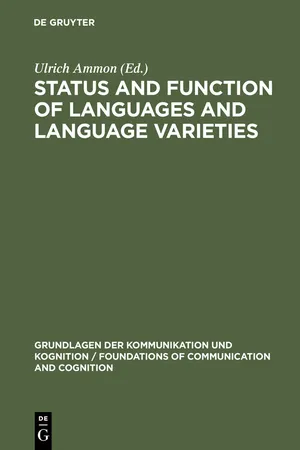
This is a test
- 675 pages
- English
- PDF
- Available on iOS & Android
eBook - PDF
Status and Function of Languages and Language Varieties
Book details
Table of contents
Citations
Frequently asked questions
At the moment all of our mobile-responsive ePub books are available to download via the app. Most of our PDFs are also available to download and we're working on making the final remaining ones downloadable now. Learn more here.
Both plans give you full access to the library and all of Perlego’s features. The only differences are the price and subscription period: With the annual plan you’ll save around 30% compared to 12 months on the monthly plan.
We are an online textbook subscription service, where you can get access to an entire online library for less than the price of a single book per month. With over 1 million books across 1000+ topics, we’ve got you covered! Learn more here.
Look out for the read-aloud symbol on your next book to see if you can listen to it. The read-aloud tool reads text aloud for you, highlighting the text as it is being read. You can pause it, speed it up and slow it down. Learn more here.
Yes, you can access Status and Function of Languages and Language Varieties by Ulrich Ammon, Ulrich Ammon in PDF and/or ePUB format, as well as other popular books in Philosophy & Philosophy History & Theory. We have over one million books available in our catalogue for you to explore.
Information
Table of contents
- Foreword
- I. General Description and Typological Schemes
- Determining the Status and Function of Languages in Multinational Societies
- Towards a Descriptive Framework for the Status/Function (Social Position) of a Language within a Country
- Naturalism and the Search for a Theory of Language Types and Functions
- Functional Types of Language in India
- Functional Aspects of Language Varieties – A Theoretical-Methodological Approach
- II. Written, Standard and Cultivated Languages or Varieties
- A Normtheoretic Approach to Functional and Status Types of Language
- Function and Status of Written Language in East Asia
- Popular and Scientific Beliefs about Language Status: An Historical Sketch
- Über den Begriff Dachsprache
- Quelque remarques relatives aux concepts Abstand et Ausbau de Heinz Kloss
- Regressed or “Downgraded” Varieties of Language: A First Approximation
- Standard English Spoken Here: The Geographical Loci of Linguistic Norms
- III. Official, National and International Languages
- Pluricentricity: National Variety
- Lingua Minor, Franca & Nationalis
- “Official Language”: the Case of Lingala
- Towards a Clarification of the Function and Status of International Planned Languages
- IV. Evaluation of Languages and Language Rights
- Towards a Value-Free Language Use Terminology
- “Mother Tongue”: the Theoretical and Sociopolitical Construction of a Concept
- Types of Language Activation and Evaluation in an Ethnically Plural Society
- V. Functional Variation within Languages or Varieties
- 20 Postulates for a General Theory of Linguistic Variants
- The Language Continuum as a Pluridimensional Concept
- On the Typology of Linguistic Repertoires (An Italo-Romance View)
- On Language Mixtures
- Acrolect and Hyperlect: Education and Class as Foci of Linguistic Identity
- Diglossia and Functional Heterogeneity
- The Status of Pitcairn-Norfolk: Creole, Dialect or Cant?
- Gooniyandi Mother-in-Law “Language”: Dialect, Register and/or Code?
- Index of Subjects